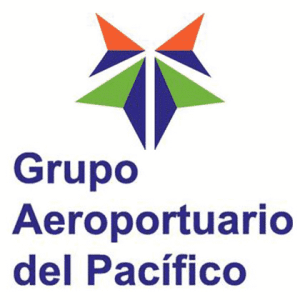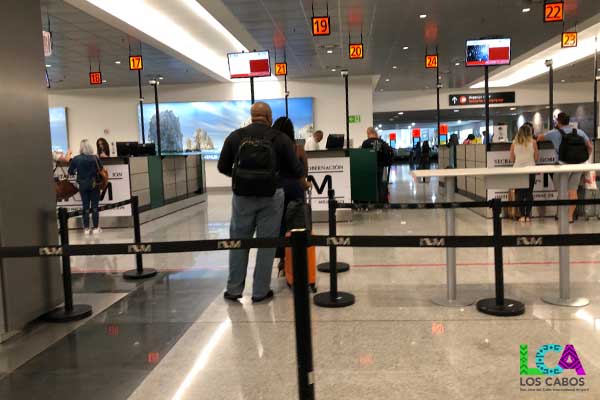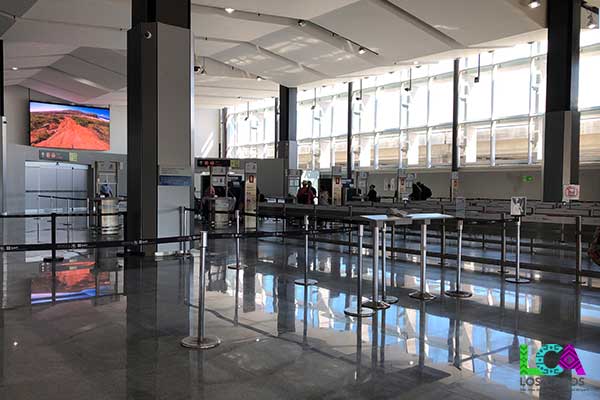Los Cabos | San Jose del Cabo International Airport
San José del Cabo International Airport (airport code of SJD) and is the 5th busiest in Mexico. The architect of Los Cabos International Airport’s 1997 renovation and expansion was Mexican architect and great-grandson of Queen Isabella II of Spain, Manuel De Santiago-de Borbón González Bravo. He was a member of ICOMOS (International Council on Monuments and Sites), and his lifetime architectural legacy to Mexico adds to 11,000,000 square meters (120,000,000 sq ft) built nationwide, including famous buildings and national sites, as well as important national restorations like the Mexican Houses of Congress Palace.

SJD Airport is the fifth-busiest airport in Mexico, located at San José del Cabo in Los Cabos Municipality, Baja California Sur state, Mexico. San Jose International Airport (SJD) is operated by the Grupo Aeroportuario del Pacífico. GAP operates 12 airports throughout the Pacific region of Mexico. These airports previously belonged to the Mexican Government. Eventually they were commissioned as part of a national initiative to privatize and improve the quality and safety of Mexico’s airport services. GAP’s mission is to provide services that contribute to the development of regional, national and international air transport in Mexico. GAP is to place the 12 airports operated by the Aeroportuario del Pacifico Group with the most advancements. GAP’s goal is to meet continuous enhancement needs and demand. The central office of GAP is located in the City of Guadalajara, in the state of Jalisco, Mexico. Tel: +33-3880-1100 LosCabosAirport.com is an independent operating website not affiliated with GAP.
SJD airport has two operating terminals. Terminal 1 operates domestic flights, and Terminal 2 operates international flights. There are currently additional modifications, enhancements to both terminals. A new FBO with 180 square meters providing more room for aircraft, passengers, and drivers is underway. This will provide better services overall for all tourists that visit the airport. There is a 3rd terminal under construction and in the near future, Terminal 4, will join Terminal 3 and operate international flights.
On September 15, 2014, Los Cabos Airport was badly damaged by Hurricane Odile. Planes were knocked against structures due to the winds from Odile. Many tourists flocked to the airport only to have to wait for days to be evacuated to other points in Mexico for connecting flights. The newest building, terminal #2, endured severe damage and therefore Los Cabos Airport was closed for 29 days. During this time the airport only received military and humanitarian supplies.
Tropical Storm Lidia was a large tropical cyclone that produced flooding in Baja California Peninsula and parts of western Mexico on August 31, 2017. The storm intensified while moving generally northward or northwestward, peaking with winds of 65 mph (100 km/h) later that day. On September 1, Lidia made landfall in Mexico near Puerto Chale, Baja California SUR, at peak intensity. The storm weakened while traversing the peninsula, ultimately emerging over the Pacific Ocean on September 3, where the storm degenerated into a remnant low.
The inner cities of Cabo San Lucas and San Jose del Cabo suffered much flooding and destruction. Heavy rainfalls rushed from the mountains taking homes, cars, garbage and lots of sand and dirt out through the arroyos to sea.
Many do not realize there are two airports int he Los Cabos region: SJD Airport (San Jose del Cabo International Airport) and, CSL Airport (Cabo San Lucas Airport). The Cabo San Lucas airport code is CSL, and you can learn more about this private airport at their website.
Learn more Mexico Customs Declaration Forms and Cabo Airport Security here.
Baja SUR is know as “Land’s End” surrounded by the Pacific Ocean and Sea of Cortez which is perfect for many water activities in Cabo. Looking for a nice Thursday night? Try to San Jose Art Walk.
In the wake of the global COVID-19 pandemic, many regions worldwide grappled with the daunting task of reopening their economies while ensuring public safety. Leading the charge in this complex endeavor was Los Cabos, Mexico, a region that not only adapted quickly to the new normal but also set an example for others to follow. [ Read the origional Cabo Airport COVID-19 Info Page ]
One of the critical steps taken by Los Cabos was the implementation of advanced COVID-19 testing facilities at its airport. This strategic move was pivotal in creating a safe travel environment for both incoming and outgoing passengers. By establishing efficient and accurate testing protocols, Los Cabos ensured that all travelers could be screened promptly upon arrival and departure, significantly reducing the risk of virus transmission and instilling confidence in travelers.
Understanding the crucial role of air travel in the region’s economy, Los Cabos worked closely with airline operators to establish rigorous safety protocols. These measures included enhanced cleaning and sanitization processes, mandatory mask-wearing policies, and social distancing guidelines. The collaborative effort with airlines demonstrated Los Cabos’ commitment to safety and its ability to adapt quickly to changing circumstances, ensuring that air travel to and from the region remained as risk-free as possible.
Los Cabos’ proactive approach extended beyond its borders, as the region took on the role of an ambassador in liaising with governments worldwide. By sharing insights, experiences, and best practices, Los Cabos played a crucial part in international dialogues about safely reopening tourist destinations. This open exchange of strategies and learning helped forge a path for other regions to follow, showcasing Los Cabos’ leadership in crisis management and public health safety.
The region’s swift and effective response to the pandemic challenges highlighted its resilience and innovative spirit. Los Cabos not only managed to protect its residents and visitors but also revived its vital tourism sector, balancing economic needs with health and safety priorities.
As the world navigates the post-pandemic era, Los Cabos stands tall as a testament to what can be achieved with foresight, collaboration, and an unwavering commitment to public health. The region’s success story serves as an inspiring model for destinations worldwide, proving that with the right approach, it’s possible to bounce back stronger and safer than ever.
Terminal Maps & More
Los Cabos Airport maps are designed to offer clarity for visitors. On these maps, travelers can easily identify the distinct terminals, with each terminal catering to specific flights—domestic, international, or charter. The maps also detail the layout of the airport, from arrival gates to baggage claim areas, helping visitors navigate the space with ease.
Import Data

Import Data

Import Data

Import Data

Import Data

Los Cabos immigration facilitates the entry and exit of travelers, ensuring compliance with Mexican immigration laws and offering assistance for a smooth travel experience.
Learn More
Los Cabos customs is responsible for monitoring the import and export of goods, enforcing regulations, and ensuring that travelers' belongings meet Mexico's import regulations.
Learn MoreVIP airport service provides a seamless, luxurious journey. Benefit from expedited arrival, swift immigration processes, exclusive lounges, and tailored support.
Reserve Now